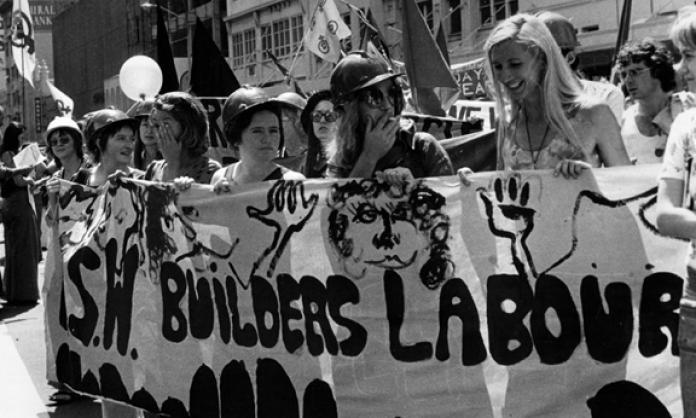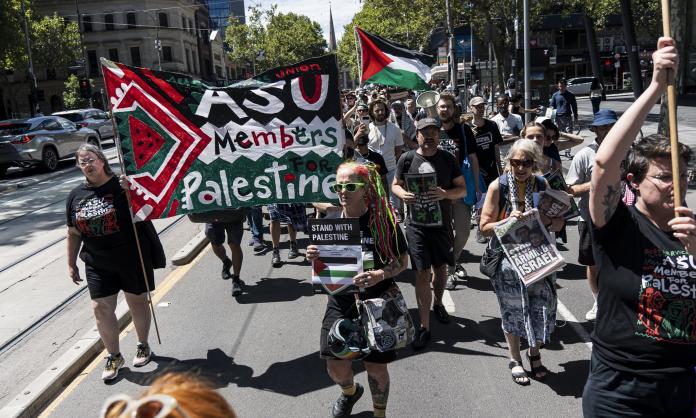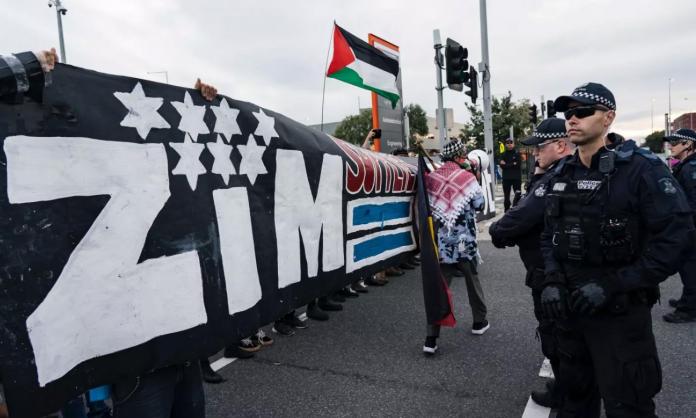You don’t get me, I’m part of the union,
Till the day I die!
The Strawbs’ hit “I’m part of the union” became an instant union anthem when it was released in 1973, a time of mass workers’ struggle around the world. You’ll still hear it today at union rallies and meetings, celebrating victories, or as a show of defiance in the face of loss.
The song goes on: “I always get my way, when I fight for higher pay”. There is no union of which this was truer than the Builders Labourers Federation (BLF).
Builders’ labourer Bobby Baker, in Making Change Happen by Kevin Cook and Heather Goodall, recalls the heady days when building workers became the scourge of the bosses and the champions of the working class in the late ’60s to early ’70s: “It was about money and conditions. The conditions ran into issues like safety and amenities … we got involved in equal pay for women and so it kept rolling along”.
It rolled along to causes such as opposition to the Vietnam War and support for Aboriginal land rights. “If they were going to send workers off to war, then it was our business. If there were black guys working on building sites, then it was our business what was happening there”, he said.
Few in the workforce today have experienced a union like the BLF. It fought for everything from equal pay for women, Indigenous rights and working class housing, to the basics of wages and conditions on the job. It did this through militant, rank and file controlled industrial action.
In today’s climate of industrial passivity, it’s no surprise that many workers don’t see the point of joining a union or don’t even know what one is. There has been a relentless war against workers over the last few decades, leading to all time lows in the level of industrial struggle and union membership. On top of this are the anti-union laws crowding the books and acting as further deterrent against action.
But this doesn’t mean unionism is dead. Survey after survey shows workers are open to joining unions, want better wages and working conditions and, when they have the opportunity, are prepared to take a stand, are prepared to fight and win.
Some might still shake their heads and wonder whether unions today could ever be like the BLF. Surely the conditions are different? Surely the BLF was a one-off? There’s no doubt we’re in a weaker position today. But there’s a lot about the BLF history still relevant.
For one, the BLF didn’t start off militant. At first it was weak, run by outright crooks in some states, covering a workforce hired by the hour, unskilled and easily replaceable. Builders’ labourers were the forgotten workers in a ruthless industry.
They were at the bottom of the pile when it came to wages and conditions and were treated like dirt by all and sundry. Yet these very same downtrodden workers built their union into one of the strongest this country has ever seen.
When Baker became a builders’ labourer things were changing. Concrete became the building material, facilitating the construction of high rise towers, speeding up jobs and generally transforming the industry and its workforce.
Bosses’ profits skyrocketed, but workers also gained something: greater strategic power. They could cost the bosses millions if they stopped a concrete pour. Larger numbers of workers on big building sites created the potential for solidarity between different building unions, and for more unity against the employers.
Just like today, when a booming economy and neoliberal policies have delivered massive profits for the bosses but worsening wages and conditions for workers, the benefits of the post-war boom overwhelmingly went to the bosses. Workers got the short end of the stick through the 1950s and early 1960s.
By end of the 1960s, workers’ fortunes began to turn. The unions were on a rising tide both in Australia and internationally. Politically, the mood was shifting.
The Australia bogged down in the war in Vietnam, in support of apartheid South Africa and socially conservative, gave way in the mid-1960s to protest and rebellion. The unions were also flexing their industrial muscle. The left controlled key unions and workplace-level organisation was strengthening.
In 1969, workers won an epic battle over the jailing of tramways union leader Clarrie O’Shea, turning the anti-union laws into a dead letter.
The BLF was able to seize this moment because of changes that occurred well before this moment. In the early 1940s, there was a battle in Victoria, albeit short, before militants in the Communist Party won leadership of the union. In Sydney a similar battle lasted a decade.
From 1951, activists such as Jack Mundey and Joe Owens in Sydney did years of patient work in a union branch where opposing the leadership usually resulted in a bashing. Starting by surreptitiously leafletting on the job, visiting workers at home and putting out a regular rank and file journal, Hoist, it took 18 months for them to hold a public meeting to which just 15 turned up!
Rank and file member Joe Ferguson, in Making Change Happen, explained: “We spoke about issues on the jobs … about no amenities … At that time you used to eat in the storeroom (where all the cement and tools were kept) … things like that. Gradually, we started to build up a bit of a following”.
A demoralising loss in 1958 union elections led to many militants quitting the union, leaving the rank and file group floundering. Though still small in number, they regrouped in time for the 1961 court-controlled election and a majority vote gave the NSW BLF a left wing rank and file leadership.
And a left wing rank and file leadership they were. They opened the office during building hours, took a builders’ labourers wage, introduced limited tenure for officials – six years on and then back on the tools. Democracy in the union was the catch cry – and implemented. Proposals for action and more general issues were voted on by members and rank and file control on the job was encouraged.
The fundamentals of unionism were critical. In Making Change Happen, Kevin Cook, an Indigenous organiser wrote, “While we got all the fame and fortune … because of the green bans, there was a fucking lot of hard industrial work went on down below you know … You’d had to fight for height money! You’d had to fight to stop somebody getting sacked!”
All this built the union’s strength. It gave members the confidence to take on issues like racism, environmentalism, housing and anti-apartheid activism. Sometimes leading, sometimes following, the actions in the NSW branch were an integral part of building a militant union across the country.
Much of the action was organised by the workers, often reporting to the union only after the blue was over. Some went further, taking over complete control of some worksites in Sydney. The Opera House was one example. Another was a Fletchers job on Kent Street.
Provocatively, Fletchers bosses called the police over alleged sabotage. Workers responded, not by striking, but working on, electing their own foreman and safety officer and deciding what work was done and how it was done until the end of the job. “What we were doing”, said union foreman Peter Barton in Pete Thomas’s Taming the Concrete Jungle, “was proving that workers could run industry and do it better than when a boss was telling us what to do”.
When it came to getting women into the industry, it was the same. Time and again the boss would tell the women to go home because there was no job for them. On one occasion, Glenys Page was ordered off a building site and when she didn’t leave, the boss called the cops. Work stopped for the rest of the day – and the following two weeks, with bans on other sites owned by the same company, until she was taken on.
For Pat Fiske, a builders’ labourer and film maker, being in the union was a no-brainer. It was an “amazing experience of collective strength”.
In a recent interview, she told me how the union’s democratic practices meant there were “fierce debates about policies like particular Green Bans, women on the job, some of the other types of bans that were put up” at members’ meetings, followed by members voting on what they wanted.
To become a union that championed the cause of the oppressed and showed what organised workers can achieve, the BLF had to build from the bottom up, from an itinerant, unskilled workforce initially unfamiliar with even the basics of unionism.
We face a similar challenge today: to rebuild from a weakened state, against a system of draconian anti-worker laws and dog-eat-dog neoliberalism.
Like the BLF did in the 1950s and 1960s, we need to return to the basics – joining up members, engaging in struggles over day to day issues in the workplace and slowly rebuilding rank and file organisation and confidence on the job.
The BLF changed the rules from the bottom up, not top down. As Pat Fiske said, the BLF members were “what the union [was] all about” and the key to its success.











